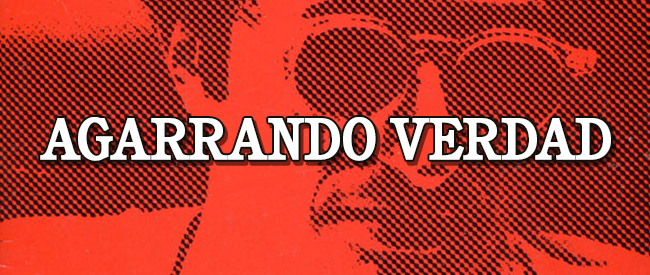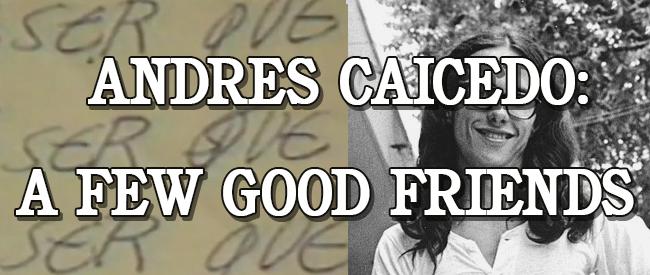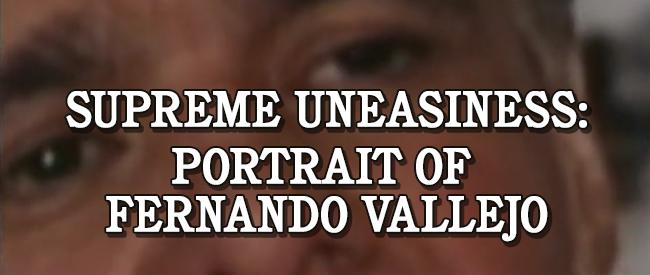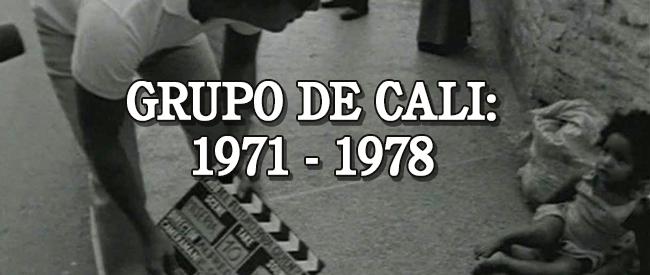
Luis Ospina was a founding member of Colombia’s Grupo de Cali, an interdisciplinary collective dedicated to capturing the vitality of Colombian life and hypocrisy in how it was presented to the world. Formed in the early 70s, the group contributed immensely to Colombia’s nearly nonexistent film industry, founding Cine Club de Cali (“The Cali Film Club”), printing the film magazine Ojo al Cine, and creating numerous documentaries and fiction films. Grupo de Cali rejected the gravity of Third Cinema tenets holding sway at the time, especially the definition of documentary as “a cinema of facts and irrefutable truth,” opting to disrupt with black humor and reveal truth as subjective.
Having attended film school at UCLA, Ospina in particular warped Hollywood genres to paradoxically reveal larger truths about Colombia’s political climate. But it’s his subversion of documentary that helped Ospina achieve his ultimate goal of preserving personalities and places from oblivion. Ospina said he would “never be able to make a film that didn’t have to do with [his] city”. Each work in this series reflects Cali’s casual horrors and wary joy – Ospina’s documentaries are not necessarily true, but always truthful.
ANDRÉS CAICEDO: UNOS POCOS BUENOS AMIGOS
aka Andrés Caicedo: A Few Good Friends
Dir. Luis Ospina, 1986.
Colombia. 82 min.
In Spanish with English subtitles.
SUNDAY, MARCH 13 – 7:30 PM
MONDAY, MARCH 21 – 7:30PM
TUESDAY, MARCH 29 – 10:00 PM
“May no one know your name and no one give you shelter. May you remain free of Fame’s foul schemes. If you leave a body of work behind, die easy, trusting in only a few good friends.”
– Andrés Caicedo, Long Live Music!
Cult author, playwright and poet Andrés Caicedo’s work captured the vitality and frustration of a generation of Colombians, avoiding magical realism’s twee sheen in favor of grounded social observation. Never directly acknowledging the heavy shadow narco-political violence cast over his city of Cali, Caicedo instead conveyed urban life’s inherent fatalism through stories of malcontent youth.
His influence resonates deeply through present-day Colombia, but as the opening scene of A FEW GOOD FRIENDS makes painfully clear, only nine years after his death no one in his hometown, forget country, remembers who he was. As the above quote suggests this is partly Caicedo’s own doing – at age 25, the day his first novel was published, he took his own life. Ospina’s documentary is an attempt to resurrect a self-erased man through his own words; taking that same quote to heart, A FEW GOOD FRIENDS focuses as much on Caicedo’s brief life and body of work as on his continued impact on friends left behind.
LA DESAZÓN SUPREMA: RETRATO INCESANTE DE FERNANDO VALLEJO
aka The Supreme Uneasiness: Incessant Portrait of Fernando Vallejo
Dir. Luis Ospina, 2003.
Colombia. 91 min.
In Spanish with English subtitles.
WEDNESDAY, MARCH 9 – 7:30 PM
FRIDAY, MARCH 25 – 10:00 PM
MONDAY, MARCH 28 – 10:00 PM
From the opening shot capturing his own shadow filming, Ospina cheerfully defies documentary’s pretense to objectivity and impartiality in his documentary on controversial author Fernando Vallejo. Best known in the U.S. for his novel Our Lady of the Assassins (later made into a film of the same name by Barbet Schroeder), Vallejo left Colombia for Mexico in 1971 after censorship of his first film. He turned to writing, and in 2007 publicly renounced his Colombian citizenship, declaring it had always been an abusive and miserable country, but upon election of then-President Álvaro Uribe found it was stupid to boot. For someone so vehemently outspoken against Colombia, all Vallejo’s work, including three films made in Mexico, centers on the country; much like Ospina, he feels an unseverable connection to his homeland in spite of its horrors and corruption.
Vallejo’s writing, nearly always first-person, blurs the line between fiction and autobiography, and Ospina’s content to let his subject dictate the form – his presence behind the camera is continually called out by Vallejo, who delights in breaking the wall between subject and filmmaker. Both act audaciously, Vallejo with his perpetual soft-spoken blasphemies, Ospina with his unabashed use of video effects including picture-in-picture, mobile graphics, and text overlay. Ospina’s is the sin of friendly informality in a genre affecting somber elegance to convey ‘serious’ intent.
Beauty isn’t necessary to portray two intertwined characters on both sides of the screen – an author who lost hope in the language of film constantly flashing new facets of personality, presented by a director who overwhelms the screen with text – both haunted by places and people that no longer exist.
GRUPO DE CALI: 1971–1978
Total running time: 68 minutes
SUNDAY, MARCH 6 – 7:30 PM
SATURDAY, MARCH 19 – 10:00 PM
WEDNESDAY, MARCH 23 – 7:30 PM
MONDAY, MARCH 28 – 7:30 PM
OIGA, VEA!
aka See, Hear!
Co-directed by Carlos Mayolo.
1971. 27 min.
Made in the style of a straight-shooting As The World Turns… style mini-documentary, OIGA, VEA! serves as psychic exposé of Cali upon the arrival of the 6th annual Panamerican Games in 1971. Shooting with a handheld 16mm camera “borrowed” from Carlos Mayolo’s ad agency workplace, the film finds wobbly panoramas on spectacular assemblages, but always from the outside – an exteriority which defines itself fuller in the film’s cockeyed dissection of the Games’ pomp and circumstance. Rallies of military might serve only to demonstrate their planners’ unmistakable Cold War anxieties, and proprietary feats of infrastructural know-how – like a new railroad track, received by some shantytowns like manna from heaven – exposed for the limited-time-only publicity perks they are. Ospina and Mayolo steal glimpses at once officially decorative and incisively marginal; by the film’s end, the bitterness engendered by the project has been transferred in total from the shantytowns outside the Games’ encampment, and directly into the audience.
CALI: LA PELICULA
aka Cali: The Movie
1973. 13 min.
The frantic, colorful CALI DE PELICULA is antithesis to the sort of pedantic ‘misery porn’ Mayolo and Ospina would mock in AGARRANDO PUEBLO. Like a Mondo movie without the voiceover, Ospina and Mayolo frame bullfighting as silent slapstick, turn voyeuristic girl-watching ominous with a horror heartbeat, and capture life at street level, a pagan carnival churning by. Dancing, so vital to social life in the area, is shown in all its movement and color, but capturing faces without smiles or real joy – even enjoying themselves Cali’s citizens are cautious.
AGARRANDO PUEBLO
aka The Vampires of Poverty
Co-directed by Carlos Mayolo.
1978. 28 min.
This program concludes with AGARRANDO PUEBLO, widely recognized as the Group’s masterpiece. Mayolo and Ospina star as effigies of themselves, wielding Bolexes and Nagras on a mission to make the perfect cine de sobreprecio (“surcharge film”) for German television – skewering a then-commonplace of Colombian cinema dictated by the Committee for Quality Control, a government-supported bureau intended to help foster a national cinema but a de facto organ of censorship. Retitled THE VAMPIRES OF POVERTY in English, “Agarrando Pueblo” mistranslates a number of ways along the lines of “the clutching of poverty” and “the tricking of the people” – Ospina described it as a popular regional phrase at the time. The certainly film gives away as much (if not more) of its antiheroes’ sleazy postcolonial errand as it does the poverty they seek. Who is clutching whom? While the filmmakers are obviously the supposed vampires, the film is also explicit in the way their exposure to an impoverished zone gets their minds going about the potential windfall for their own careers (aided, inevitably, by a few lines of blow back at the hotel.)
In his The Aesthetic of Hunger (first presented at a festival in 1965, modified and republished in the early 70s) Brazilian filmmaker Glauber Rocha criticized a certain trend in Latin American cinema that played up tropes of poverty as a kind of image-dependency. Rocha posited that these countries were still living under the same colonialism as yesteryear, only the means of representation (establishing poverty as an indomitable symptom/destiny, and not the result of socioeconomic policies) had changed.
The tension of this encounter – between the type of European-inflected filmmakers Rocha referred to as “above zero” for their filmmaking resources, and Cali’s poorest – reaches a remarkable boiling point in AGARRANDO PUEBLO. It’s unclear whether the documentarians’ expedition is being turned on its head, or in fact fulfilling its original intent too perfectly; the barrier between color footage of the slums and black-and-white footage of the filmmakers gets shakier. As Mayolo himself likened the experience of shooting OIGA, VEA! to having “150 assistant directors”, PUEBLO brings it all back home when one of the documentary’s “stars” refuses to participate, becoming all the more desirable a subject for the filmmakers. The man is played by one Luis Alfonso Londo, a longtime resident of the El Guabal shantytown profiled in OIGA, VEA! According to the filmmakers, they first met Londo when he jumped out and asked them: “Ah, con que agarrando pueblo, no?”




One thought on “AGARRANDO VERDAD”
Comments are closed.